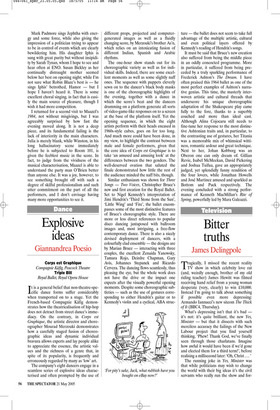Explosive ideas
Giannandrea Poesio
Corps est Graphique Compagnie Kdfig, Peacock Theatre Triple Bill Royal Ballet, Royal Opera House
It is a general belief that non-theatre-specific dance forms suffer considerably when transported on to a stage. Yet the French-based Compagnie Käfig demonstrates how the theatricalisation of hip-hop does not detract from street dance’s immediacy. On the contrary, in Corps est Graphique, the artistic director and choreographer Mourad Merzouki demonstrates how a carefully staged fusion of choreographic ideas and dynamic individual bravura allows experts and lay people alike to appreciate the essence, the artistic values and the richness of a genre that, in spite of its popularity, is frequently and erroneously regarded by many as ‘low’ art.
The company’s eight dancers engage in a seamless series of explosive ideas characterised and often prompted by the use of different props, projected and computergenerated images as well as a fluidly changing score, by Merzouki’s brother As’n, which relies on an intoxicating fusion of different Indian, Spanish and Arabic rhythms.
The one-hour show stands out for its choreographic variety as well as for individual skills. Indeed, there are some excellent moments as well as some slightly naff ones. The sequence with puppets cleverly sewn on to the dancer’s black body masks is one of the choreographic highlights of the evening, together with a dance in which the score’s beat and the dancers drumming on a platform generate all sorts of video-game-like responses on to a screen at the base of the platform itself. Yet the opening sequence, in which the eight artists perform with their heads encased in 1960s-style cubes, goes on for too long. And much more could have been done, in my view, to highlight the contrast between male and female performers, given that the core idea of Corps est Graphique is to take ‘an amused and amusing look’ at the differences between the two genders. The well-deserved ovation that saluted the finale demonstrated how little the rest of the audience minded the naff bits, though.
Similar enthusiasm was shown for Three Songs — Two Voices, Christopher Bruce’s new and first creation for the Royal Ballet. Set to Nigel Kennedy’s interpretation of Jimi Hendrix’s ‘Third Stone from the Sun’, ‘Little Wing’ and ‘Fire’, the ballet encompasses some of the most distinctive features of Bruce’s choreographic style. There are more or less direct references to popular disco dancing juxtaposed with ballroom images and, most intriguing, a free-flow contemporary dance. There is also a nicely devised deployment of dancers, with a colourfully clad ensemble — the designs are by Marian Bruce — interacting with three couples, the excellent Zenaida Yanowsky, Tamara Rojo, Deirdre Chapman, Gary Avis, Johannes Stepanek and Ricardo Cervera. The dancing flows seamlessly, thus pleasing the eye, but the whole work does not have the drive or the impact one expects after the visually powerful opening moments. Despite some choreographic subtleties — such as the use of gestures corresponding to either Hendrix’s guitar or to Kennedy’s violin and a cyclical, ABA struc ture — the ballet does not seem to take full advantage of the multiple artistic, cultural and even political layers offered by Kennedy’s reading of Hendrix’s songs.
It must be said that Bruce’s new creation also suffered from being the middle piece in an oddly concocted programme. More in particular, it suffered from being preceded by a truly sparkling performance of Frederick Ashton’s The Dream. I have often praised this 1964 ballet as one of the most perfect examples of Ashton’s narrative genius. This time, the masterly interwoven artistic and cultural threads that underscore his unique choreographic adaptation of the Shakespeare play came fully to the fore, thanks to a superbly coached and more than ideal cast. Although Alina Cojocaru still needs to fine-tune her response to the most distinctive Ashtonian traits and, in particular, to the contrasting use of gestures, her Titania was a memorable mix of whimsical wittiness, romantic ardour and great technique. Next to her, Johan Kobborg was an Oberon one can only dream of. Gillian Revie, Isabel McMeekan, David Pickering and Joshua Tuifua, gave an appropriately judged, yet splendidly funny rendition of the four lovers, while Jonathan Howells and José Martinez amused and sparkled as Bottom and Puck respectively. The evening concluded with a strong performance of Kenneth MacMillan’s Rite of Spring, powerfully led by Mara Galeazzi.

























































 Previous page
Previous page